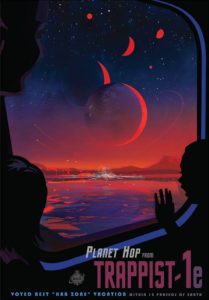Exoplanets are cool but Earth is where we keep our stuff
I was as excited as anyone about the news of seven planets orbiting a dwarf star, all of which are in the ‘Goldilocks zone’ (neither too close to their star nor too far) wherein they could conceivably harbor life. The memes came fast and thick for a couple of days, including this imaginary travel poster:

But as fun as it is to conceive of interstellar travel and space vacations, the truth is that the challenges that must be overcome for humans to leave the solar system are all but insurmountable. Even spreading out to nearby worlds such as our moon and Mars would require Herculean effort. The real challenge for the human species is learning to coexist on planet Earth without destroying ourselves through war and environmental degradation.
That we keep looking for “life out there” speaks to mankind’s boundless curiosity and sense of adventure, and perhaps to a desire to find an alternative to living with the lifeforms that we’re stuck with here. Like all those idiots who voted the opposite of you a few months ago.
But the physics of the Universe, with its limiting speed of light and its dimensions in the tens of billions of light years, confines us to our local star system pretty well. I recall a sci-fi short story by Stanislaw Lem, in which he speculated that this is actually the design of the Universe, which is a vast experimental laboratory for the generation of intelligent life.
The calling of the human race is not to planet hop throughout the galaxy, as much as sci-fi fans would like to think it is. Our calling is to take care of the planet we inherited, and of each other. It is to evolve our capacity for love right here on Earth.